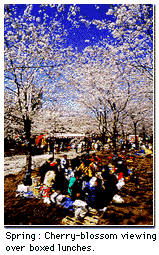 |
What are the characteristics of each season?
|
 |
Because Japan stretches north to south, the climate tends to differ widely from one region to the next region. But in overall terms the country has a mild, humid climate with four clearly distinct seasons.
 Winters on the Sea of Japan side of the country are usually quite snowy, but the Pacific Ocean side is relatively warm and free of precipitation. This is due to the currents that flow into Japan and the spine of mountains running the length of the archipelago.
Winters on the Sea of Japan side of the country are usually quite snowy, but the Pacific Ocean side is relatively warm and free of precipitation. This is due to the currents that flow into Japan and the spine of mountains running the length of the archipelago.
|
|
 Spring is warm, and the winds are calm, but from around mid-June the country enters a month-long rainy season. There is another period of frequent rainfall in early autumn.
Spring is warm, and the winds are calm, but from around mid-June the country enters a month-long rainy season. There is another period of frequent rainfall in early autumn.
 Japan's summers are usually sunny, and in most parts of the country the intense heat and humidity forces people to keep their homes and workplaces air conditioned.
Japan's summers are usually sunny, and in most parts of the country the intense heat and humidity forces people to keep their homes and workplaces air conditioned.
|
|
 From late summer to autumn, many tropical storms develop in the Pacific that turn into typhoons by the time they reach Japan. The country's southwestern districts are particularly prone to typhoons, which can cause great damage with their violent downpours, strong winds, and landslides. As soon as the rainy days of early autumn pass, the fall skies turn a deep, invigorating blue.
From late summer to autumn, many tropical storms develop in the Pacific that turn into typhoons by the time they reach Japan. The country's southwestern districts are particularly prone to typhoons, which can cause great damage with their violent downpours, strong winds, and landslides. As soon as the rainy days of early autumn pass, the fall skies turn a deep, invigorating blue.
Photos courtesy of Tokyo Metropolitan Government.
|

 |